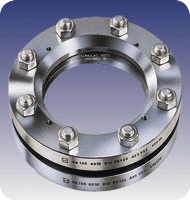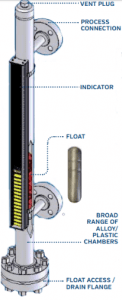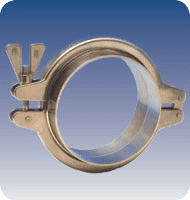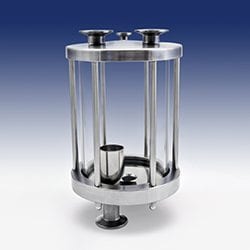What Is The Purpose Of A Sight Glass?
Posted on October 21, 2019 by LJ Star The purpose of a sight glass is to allow plant managers and engineers to look inside of their systems without disrupting the environment within. Often referred to as viewing glasses, they offer you a way to see the levels of liquids or gases that are traveling through a critical point of your design, monitor pressure changes, and virtually anything else that sight glass windows could allow you to do. With their widespread use, sight glasses have become critical to operations such as steam pipelines, chemical processing, pharmaceutical processing, and food processing.
The purpose of a sight glass is to allow plant managers and engineers to look inside of their systems without disrupting the environment within. Often referred to as viewing glasses, they offer you a way to see the levels of liquids or gases that are traveling through a critical point of your design, monitor pressure changes, and virtually anything else that sight glass windows could allow you to do. With their widespread use, sight glasses have become critical to operations such as steam pipelines, chemical processing, pharmaceutical processing, and food processing.
Often simple in design, rudimentary sight glasses of the past consisted of a glass tube that was linked to an important part of your system, like a tank or a gas inlet. Modern industrial sight glasses are made from a glass disk that’s securely held by bolts and gaskets between two metal frames, with the goal of maintaining the standards of sanitary fittings. The glass that’s used is typically soda lime glass or borosilicate glass, while stainless steel is the go-to choice for the metal due to its superior strength and abrasion resistance, even with 304 steel.
It’s necessary for a sight glass to be able to withstand whatever materials and fluids it will come into contact with so that the glass does not tarnish or degrade, impairing your ability to use it for system monitoring. Assuming it’s kept in good condition, using a sight glass is as user-friendly as it is essential. When looking into a sight glass, the level of fluid present against the glass represents the level of fluid that you have at that point of your system. Bubbles against the glass show you that you have a liquid/vapor mix. If you’re looking at clear glass while your system is running, then that means that you have a full line of liquid (or complete lack thereof). Patterned backplates or striped inserts make it easier to see the fluid levels and check them against desired outcomes. <.p>
This is especially important for applications like steam boilers. With a steam boiler, you need to keep boiler water levels within a certain range to maintain operations and prevent system failure. Luckily, since the pressure of the water below and the steam above is equal, you can use a sight glass to see any change in the boiler’s water level. A steam boiler’s sight glass gauge usually has two different index marks: a low-water threshold and a high-water threshold. Go too far above the top mark and you risk overfilling the boiler, which can prevent steam from rising up into your system. Go too far below the lower threshold without shutting your boiler down and you risk damaging your equipment from the heat, which could also lead to a dangerous fire or explosion.
Beyond these applications, sight glasses can be helpful anywhere that you wish to see inside of your equipment. In the food and beverage or pharmaceutical industries, where you have fluid that’s put under high temperatures or extreme pressures, sight glasses allow you to take a look inside without having to worry about flaking, explosions, or corrosion. If you’re working with a heater that runs on gas or kerosene, a sight glass can let you see if the pilot light is on or not, as well as make sure that all of the heater’s jets are working properly. If you’re working with equipment that’s prone to clogging, like a dust collector, then you can use a sight glass to make sure that critical points in your process are free of debris. They can also be used anywhere that you want to confirm that your materials are flowing freely or watch the blending of materials.
Since sight glasses can be connected to crucial (and volatile) parts of your system, it’s necessary to make sure that they are sturdy enough to handle operations. Tempering and reinforcing your gauge glass can reduce the risk of sight glass failure. By making your sight glass as tough as possible, you ensure that the device it’s connected to will function properly while offering you the chance to monitor everything safely.
With the various sizes and styles of sight glasses, you should be able to find one that’s perfectly fitted to the specific needs of your operation. To improve performance and functionality, sight glass accessories can help you to get the most out of your sight glass. Top sight glass accessories include:
- Wipers: aid in visibility by cleaning the inside glass surface of any light ports and sight ports
- Spray rings/nozzles: delivers a variety of fluid or air spray media to aid in glass cleaning
- Heating jackets: prevents cool spots in the process line while maintaining a clear view of the manufacturing process
- Light timers: switches lights on and off automatically, reducing power consumption and heat build-up while improving lamp life
How to Select the Right Sight Glass
Learn more by watching our webcast on sight glass selection and maintenance.
Subscribe to our Blog
Categories
- Certifications
- Company
- In The News
- Industry Information
- METAGLAS® Sight Glasses
- PackExpo 2020
- Sanitary Clamps
- Sanitary Fittings
- Sight Flow Indicator Benefits
- Sight Glass Applications
- Sight Glass Construction
- Sight Glass Lighting
- Sight Glass Lights
- Sight Glass Process Vessel Camera
- Sight Glasses
- Trade Shows
- Webcast


